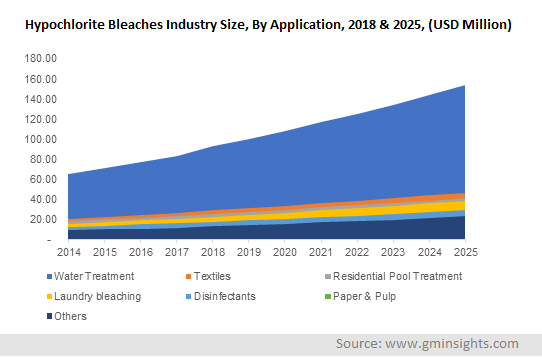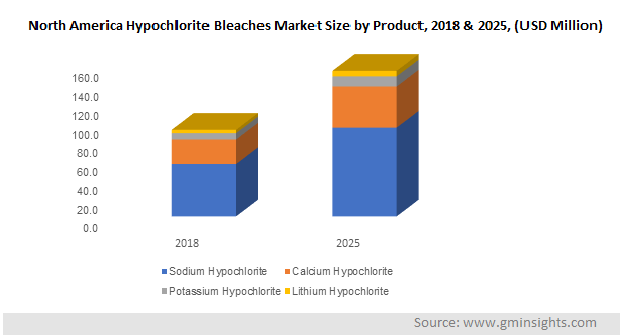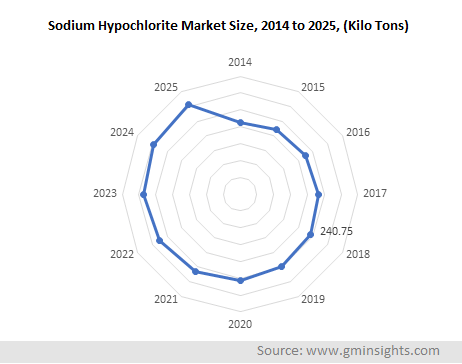Home > Chemicals & Materials > Specialty Chemicals > Custom Synthesis > Hypochlorite Bleaches Market
Hypochlorite Bleaches Market Analysis
- Report ID: GMI3653
- Published Date: Oct 2019
- Report Format: PDF
Hypochlorite Bleaches Market Analysis
The main objective of hypochlorite bleaches agent is to get sufficiently high and uniform degree of whiteness in the textile material such as cotton which may drive the growth of hypochlorite bleaches market. These ingredients remove the coloring material from the cotton or other natural fibers to confer a white presence to the material. In addition, bleaching results in an upsurge in levelness of pretreatment, absorbency, and complete removal of seed husks and trash.
Sodium hypochlorite is considered as an active textile bleaching agent as it leaves a fabric soft without depriving its quality. Increased concentration of this product up to 12% can effectively accelerate the color fading effect providing white fabric.
Various manufacturers are offering potassium hypochlorite bleaches to meet rising demand for bleaching agents in laundry, agriculture and industrial applications. The popularity of western lifestyle among millennials has augmented the usage of high brand clothing globally. These hypochlorite bleaches assure minimum fabric degradation and reduce the color fading effect which maintains the overall clothing quality for longer time periods.
Agricultural land requires water in huge quantities for various purposes such as irrigation, pesticide and fertilizer application and for growing fresh produce. When agricultural water is used safely and effectively, crop yield and production are positively affected. The agricultural water is majorly sourced from surface water such as rivers, streams, open canals, reservoirs and rainwater.
This water needs to be disinfected before incorporating into agricultural land which foster production and yield. Potassium hypochlorite bleaches solutions are used in agricultural land as it offers essential plant nutrients and get dissolves easily with water.

Various pollutants are introduced to the swimming pool which are derived from skin and excretion products of swimmers. Pollutants which are entered in water through swimmers includes bacteria from saliva, sebum, sweat and cosmetics. The impurities range from waterborne transferrable bacteria and viruses to dissolved & undissolved matter. This initiates to a need for an effective water treatment to safeguard a fit swimming pool atmosphere.
Improperly balanced water may irritate the skin and eyes and the water can also get cloudy owing to its low chlorine content requires pool treatment. Chlorination remains the most popular residential pool water treatment technique. In this process common chlorine compounds such as sodium and potassium hypochlorite are added which share the property of forming free chlorine in water solution which is accessible for water disinfection.
Emerging regulations on residential pool water quality which may foster awareness regarding diseases such as cryptosporidiosis, giardiasis and shigellosis. The growing necessity for ease of pool water preservation is bringing in usage of more hypochlorite bleaches chemicals for residential pool water treatment.

Rising industrial activities and growing contamination have propagated the need for water treatment activities in the region. Demand for safe and potable water in the region owing to growing consumer consciousness for healthy living is likely to upsurge hypochlorite bleaches market. U.S. consumes at over 40 billion gallons of water per day, out of which, more than 75% instigates from reservoir, oceans, lakes and rivers. The remaining is attained from groundwater systems.
About 64% of all community water systems in the U.S. use chlorine to disinfect their water. Calcium hypochlorite is added in municipal water treatment plants as it used as a powerful oxidizing agent which averts percolation of bacteria in water. The EPA issued a registration standard for sodium and calcium hypochlorite usage ranging from 5.25% to 12.5% and 65% to 70% with category 1 labelling in municipal water treatment.

